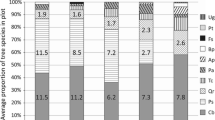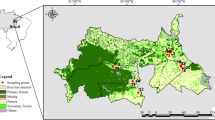Abstract
Old-growthPseudotsuga-Tsuga forests of the Pacific Northwest Coast of North America are characterized by the presence of large, old trees ofPseudotsuga menziesii var.menziesii (Douglas-fir). Colonizing soon after a stand-replacing disturbance,P. menziesii persists in these forests, coexisting for centuries with the late-successional species.P. menziesii survives by maintaining emergent status in the uppermost part of the forest canopy, above the crowns of competing late-successional species. After reaching maximum tree height and crown size,P. menziesii maintains shoots and foliage of the established crown by epicormic shoot production. In this review, we propose that attaining emergent status in the upper canopy combined with the process of crown maintenance contributes to the persistence ofP. menziesii into later stages of succession, making this species a long-lived pioneer that between infrequent disturbances can coexist with late-successional species for centuries.
Similar content being viewed by others
References
Agee J.K. (1991): Fire history of Douglas-fir forests in the Pacific Northwest.USDA Forest Serv. Gen. Techn. Rep. PNW-285: 25–33.
Agee J.K. (1993):Fire ecology of Pacific Northwest forests. Island Press, Washington, D.C.
Aiba S. &Kohyama T. (1996): Tree species stratification in relation to allometry and demography in a warm-temperate rain forest.J. Ecol. 84: 207–218.
Attiwill P.M. (1994): Ecological disturbance and the conservative management of eucalypt forests in Australia.Forest Ecol. Managem. 63: 301–346.
Bégin C. &Filion L. (1999): Black spruce (Picea mariana) architecture.Canad. J. Bot. 77: 664–672.
Bryan J.A. &Lanner R.M. (1981): Epicormic branching in Rocky Mountain Douglas-fir.Canad. J. Forest Res. 11: 190–199.
Cody M.L. (1986): Structural niches in plant communities: In:Diamond J. &Case T.J. (eds.),Community ecology, Harper & Row, New York, pp. 381–405.
Easter M.J. &Spies T.A. (1994): Using hemispherical photography for estimating photosynthetic photon flux density under canopies and gaps in Douglas-fir forests of the Pacific Northwest.Canad. J. Forest Res. 24: 2050–2058.
Enright N.J., Ogden J. &Rigg L.S. (1999): Dynamics of forests withAraucariaceae in the western Pacific.J. Veg. Sci. 10: 793–804.
Ewers F.W. (1983): The determinate and indeterminate dwarf shoots ofPinus longaeva (bristlecone pine).Canad. J. Bot. 61: 2280–2290.
Franklin J.F., Cromack K., Denison W., McKee A., Maser C., Sedell J., Swanson F. &Juday G. (1981): Ecological characteristics of old-growth Douglas-fir forests.USDA Forest Serv. Gen. Techn. Rep. PNW-118: 1–48.
Franklin J.F. &DeBell D.S. (1988): Thirty-six years of tree population change in an old-growthPseudotsuga-Tsuga forest.Canad. J. Forest Res. 18: 633–639.
Franklin J.F. &Dyrness C.T. (1973):Natural vegetation of Oregon and Washington. Oregon State University Press, Corvallis.
Franklin J.F. &Hemstrom M.A. (1981): Aspects of succession in the coniferous forests of the Pacific Northwest: In:West D.C., Shugart H.H. &Botkin D.B. (eds.),Forest succession, Springer-Verlag, New York, pp. 212–229.
Gholz H.L., Fitz F.K. &Waring R.H. (1976): Leaf area differences associated with old-growth forest communities in the western Oregon Cascades.Canad. J. Forest Res. 6: 49–57.
Ishii H. (2000):A canopy perspective of community dynamics in an old-growth Pseudotsuga-Tsugaforest. Ph.D. Dissertation, College of Forest Resources, University of Washington, Seattle.
Ishii H. &Ford E.D. (2001): The role of epicormic shoot production in maintaining foliage in oldPseudotsuga menziesii (Douglas-fir) trees.Canad. J. Bot. 79: 251–264.
Ishii H., Reynolds J.H., Ford E.D. &Shaw D.C. (2000): Height growth and vertical development of an old-growthPseudotsuga-Tsuga forest in southwestern Washington State, USA.Canad. J. Forest Res. 30: 17–24.
Ishii H. &Wilson M.E. (2001): Crown structure of old-growth Douglas-fir in the western Cascade Range, Washington.Canad. J. Forest Res. 31: 1250–1261.
Kohyama T. (1993): Size-structured tree populations in gap-dynamic forest — the forest architecture hypothesis for the stable coexistence of species.J. Ecol. 81: 131–143.
Larson B.C. (1986): Development and growth of even-aged stands of Douglas-fir and grand fir.Canad. J. Forest Res. 16: 367–372.
Lindenmayer D.B., Cunningham R.B., Donnelly C.F. &Franklin J.F. (2000): Structural features of old-growth Australian montane ash forests.Forest Ecol. Managem. 134: 189–204.
Moffett M.W. &Lowman M.D. (1995): Canopy access techniques: In:Lowman M.D. &Nadkarni N.M. (eds.),Forest canopies, Academic Press, San Diego, pp. 3–26.
Munger T.T. (1940): The cycle from Douglas-fir to hemlock.Ecology 21: 451–459.
Ogden J. &Stewart G.H. (1995): Community dynamics of the New Zealand conifers: In:Enright N.J. &Hill R.S. (eds.),Ecology of the southern conifers, Melbourne University Press, Melbourne, pp. 81–119.
Remphrey W.R. &Davidson C.G. (1992): Spatiotemporal distribution of epicormic shoots and their architecture in branches ofFraxinus pennsylvanica.Canad. J. Forest Res. 22: 336–340.
Spies T.A. &Franklin J.F. (1989): Gap characteristics and vegetation response in coniferous forests of the Pacific Northwest.Ecology 70: 543–545.
Spies T.A., Franklin J.F. &Klopsch M. (1990): Canopy gaps in Douglas-fir forests of the Cascade Mountains.Canad. J. Forest Res. 20: 649–658.
Stephenson N.L. (1994): Long-term dynamics of giant sequoia populations: Implications for managing a pioneer species: In:Aune P.S. (ed.), Symposium on Giant Sequoias: Their Place in the Ecosystem and Society, USDA Forest Serv. Gen. Techn. Rep. PSW-151: 56–63.
Stewart G.H. (1986): Population dynamics of a montane conifer forest, Western Cascade Range, Oregon, USA.Ecology 67: 534–544.
Stewart G.H. (1989): The dynamics of old-growthPseudotsuga forests in the western Cascade Range, Oregon, USA.Vegetatio 82: 79–94.
Waring R.H. &Franklin J.F. (1979): Evergreen coniferous forests of the Pacific Northwest.Science 204: 1380–1386.
Westing A.H. (1964): The longevity and aging of trees.Gerontologist 4: 10–15.
Wierman C.A. &Oliver C.D. (1979): Crown stratification by species in even-aged mixed stands of Douglas-fir — western hemlock.Canad. J. Forest Res. 9: 1–9.
Author information
Authors and Affiliations
Corresponding author
Rights and permissions
About this article
Cite this article
Ishii, H., Ford, E.D. Persistence ofPseudotsuga menziesii (Douglas-fir) in temperate coniferous forests of the Pacific Northwest Coast, USA. Folia Geobot 37, 63–69 (2002). https://doi.org/10.1007/BF02803191
Issue Date:
DOI: https://doi.org/10.1007/BF02803191




